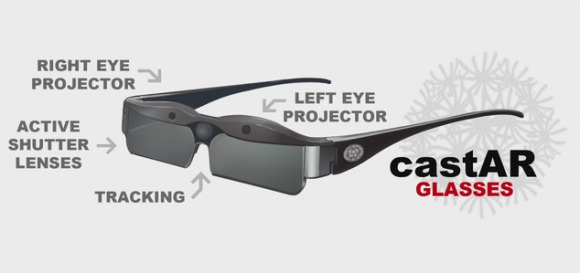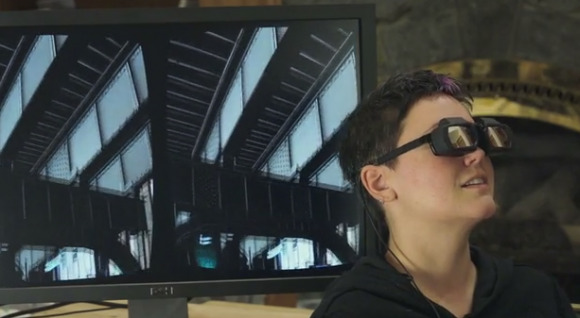castAR Augmented Reality Glasses Switch To True VR With A Clip
There's a team of creators out in the wild this week showing off a pair of augmented reality / virtual reality glasses called castAR, a pair of glasses that's set to make Star Wars a reality. The inspiration for this wearable piece of technology comes directly from the first Star Wars movie, A New Hope, in a scene where the droids are playing a 3D chess game with Chewbacca. In this scene, the pieces for the chess game, (called a Djarik hologame, for you hardcore nerds), are standing projected above the board in 3D – this inspiration pushed the creators of castAR to make a pair of glasses that uses a mix of augmented reality and projection to make a whole new environment for the user.
You'll find this first set of castAR glasses works with a tracking system in its center (on your nose) alone with right and left eye projectors and active shutter lenses. Like the solution we were working with on NVIDIA Shutter Glasses and the still-running-strong NVIDIA 3D Vision, these glasses actually flash images to your left and right eye to bring a whole different level of 3D sight. A new era in front of the original red and blue lenses of old.

Each projector in this pair of glasses refreshes at 120 hertz, and you've got two different ways to use them. There's true AR or true VR. With true AR, you're seeing images projected out into the world – augmenting the real world, as it were. With true VR, you're working with a clip-on that reflects the projections to a retro-reflective surface, allowing you to see a fully synthesized environment.
In other words, this system may very well be ready to replace any other head mounted display on the market.

You'll be seeing these glasses connected to a wire on one end, with information being fed from a computer down onto the surface at hand. There's also a special "wand" that'll allow users to interact with the 3D environment and a variety of trackable game pieces that are easily retro-fitted to game pieces already on the market.
NOTE: Turn your audio down before playing this video (it's loud).
You'll also notice that the projected images from the glasses don't wiggle and move when the head of the user moves – they're utilizing the motion tracking embedded within themselves to stay steady. You'll also find the focus point for the user to be as far away as the projection screen itself – much easier on the eyes than previous solutions.
Above you'll see a bit more of this motion tracking in a real test experiment with a couple of surfaces. Pay special attention to the point at which a new roll of projection paper is unfurled – instant workability.
This system is being worked on by the likes of Technical Illusions – that's the team of Jeri Ellsworth and Rick Johnson, both former Valve Software engineers and together aiming to push the world of augmented reality and virtual reality into one unique pair of glasses.
